You can keep food cold using an ancient evaporative cooling method that dates back to 3000 BC. This technique involves nesting a smaller clay pot inside a larger one, with damp sand filling the gap between them. Cover the top with a wet cloth and place in a shaded, ventilated area. The water's evaporation through the porous clay creates a natural cooling effect, dropping temperatures up to 10°C below the surrounding air. This simple yet effective method can extend produce shelf life by up to 600% compared to conventional storage, making it ideal for areas without electricity. Discover how this sustainable cooling solution could transform your food preservation approach.
Ancient Origins of Clay Cooling
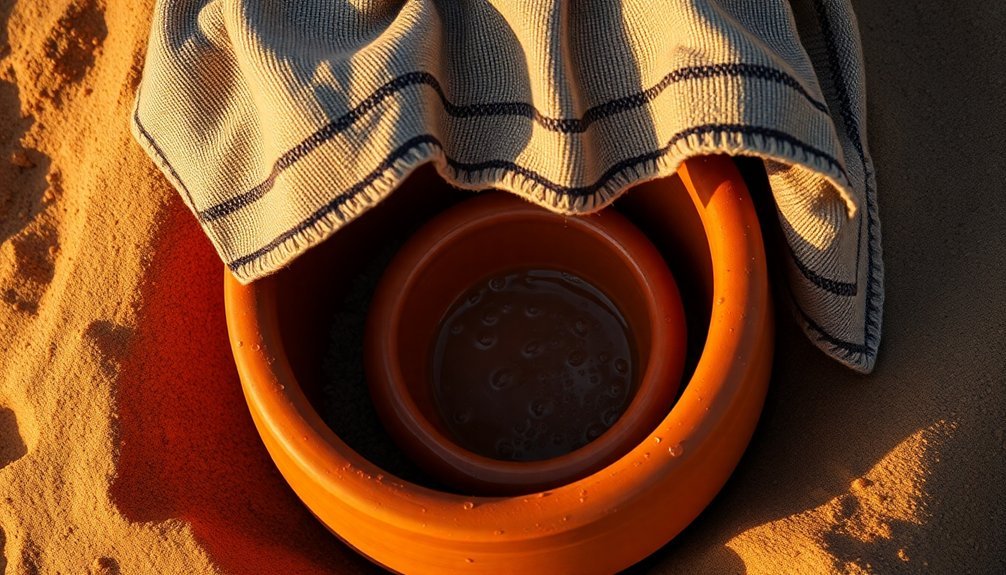
Clay pot cooling traces its roots to some of humanity's earliest civilizations, with the Indus Valley and ancient Egyptian cultures pioneering these techniques as far back as 3000 BC.
These ancient societies discovered that porous clay vessels could effectively cool water through evaporation, a principle they'd continue to refine over centuries. This traditional method experienced a remarkable revival when Mohamed Bah Abba revolutionized it in Nigeria during the 1990s.
In ancient Egypt, you'll find evidence of sophisticated cooling methods depicted in frescoes and funerary papyri. The Egyptians didn't just rely on the natural properties of clay; they actively enhanced the cooling effect by fanning water jars to increase evaporation.
They developed different types of vessels, including the larger zeer and smaller personal qulla, each designed for specific cooling needs.
If you'd explored these ancient civilizations, you'd have seen how they integrated clay pot cooling into their daily lives and architecture. They combined these cooling vessels with other innovative features like windcatchers (malqaf) and underground cooling systems.
The Romans later adopted similar principles, using aqueducts and water for cooling their homes, while the Chinese developed their own variations using rotary fans and water fountains.
How Clay Pots Work
You'll find the natural cooling process of clay pots remarkably straightforward, as water molecules evaporate through the porous clay walls and carry heat away from the inner chamber.
The temperature control elements include the essential wet sand between two nested pots, creating a consistent cooling environment that can lower temperatures up to 10°C below the surrounding air. The system's internal aluminum radiator helps circulate the cooled air effectively throughout the chamber.
Your clay pot cooler works best in dry, well-ventilated areas where airflow enhances the evaporation process, making it an effective solution for preserving food without electricity.
Natural Cooling Process
The natural cooling process behind clay pot refrigeration relies on three key principles of evaporative cooling. When water evaporates from the outer surface of your clay pot, it pulls heat away from the interior, similar to how your body cools itself through sweating. This process can lower the temperature inside your pot by up to 10°C below the surrounding air temperature, creating an effective cooling environment for your food.
You'll need two unglazed clay pots of different sizes, with sand filling the gap between them. The porous nature of the clay allows water to seep through gradually, while the wet sand maintains consistent moisture for continuous evaporation. With costs ranging from $5-$40, this affordable cooling solution is accessible to many households.
When you keep the setup in a shady, well-ventilated area and cover it with a damp cloth, you'll enhance the cooling effect even further. The increased humidity inside your pot helps preserve produce longer, turning what might be a single day's shelf life for leafy greens into more than four days of freshness.
This natural refrigeration method works best when you regularly add water to the sand and maintain proper airflow around the pots.
Temperature Control Elements
Building on these natural cooling principles, several key elements work together to control temperature in your clay pot setup. The arrangement of a smaller pot nested within a larger one creates an important cooling chamber, with sand filling the gap between them.
You'll need to keep this sand consistently moist, as it's vital for the evaporative cooling process. The wet cloth or sack covering your cooler serves as more than just a lid – it's an active component that enhances the cooling effect through additional evaporation.
When you place the cooler in a shaded, well-ventilated area, you're maximizing its ability to maintain temperatures up to 10°C below the surrounding air temperature. The setup creates a controlled microclimate where humidity levels rise, which helps preserve your produce more effectively.
You'll only need to add 1-3 liters of water daily to maintain the cooling effect, making this an efficient system. By following proper storage practices and keeping the sand wet, you're ensuring consistent temperature control that can extend the shelf life of your produce from one day to more than four days.
Building Your Clay Pot Cooler
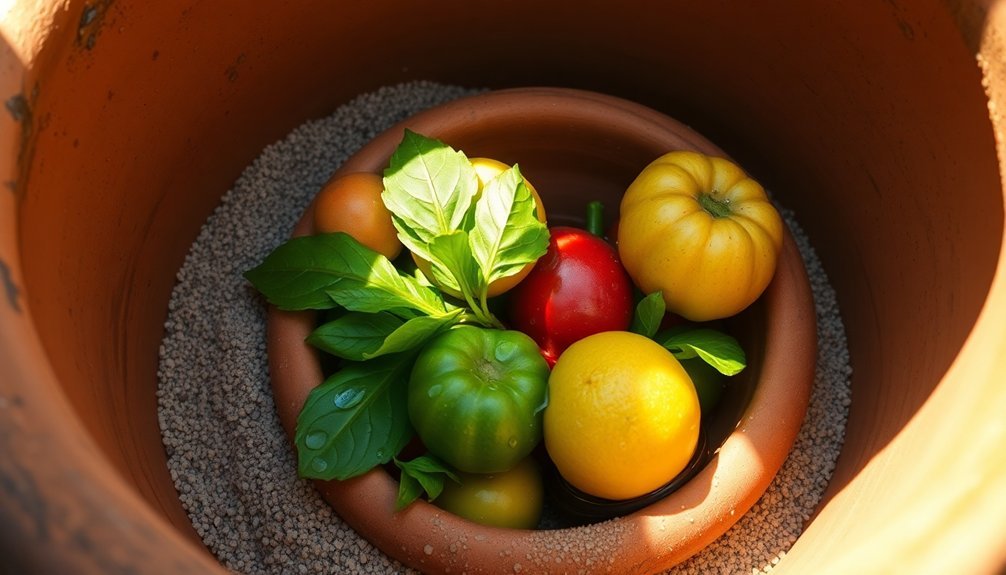
Cover the top of your assembled cooler with a wet cloth or sack to complete the setup.
You'll need to maintain moisture levels by regularly wetting the sand and covering cloth, as the cooling effect depends on continuous evaporation.
The entire setup can cost between $5 and $40, depending on pot sizes and local material costs.
With proper maintenance, your clay pot cooler can reduce temperatures by up to 10°C below the surrounding air temperature.
Best Storage Locations
Successfully operating your clay pot cooler depends heavily on choosing an ideal location that maximizes its cooling potential.
You'll want to place your cooler in a dry, shaded area with good air circulation, away from any direct sunlight or heat sources.
The best spots are typically well-ventilated spaces like verandas or porches where natural breezes can flow freely around the cooler. If you're placing it indoors, choose a room with consistent airflow and keep it near a window or doorway where air movement is steady.
Make certain you've got easy access to water, as you'll need to maintain the dampness of the sand and cloth daily.
Ground level or slightly elevated positions work best for maintaining stable temperatures. You don't need a dedicated space – underutilized areas of your home can work perfectly as long as they meet the basic requirements.
The location should have relative humidity below 40% and daily temperatures above 25°C for peak performance.
Remember to keep the area around your cooler unobstructed to guarantee proper airflow, which is essential for the evaporative cooling process to work effectively.
Food Preservation Capabilities
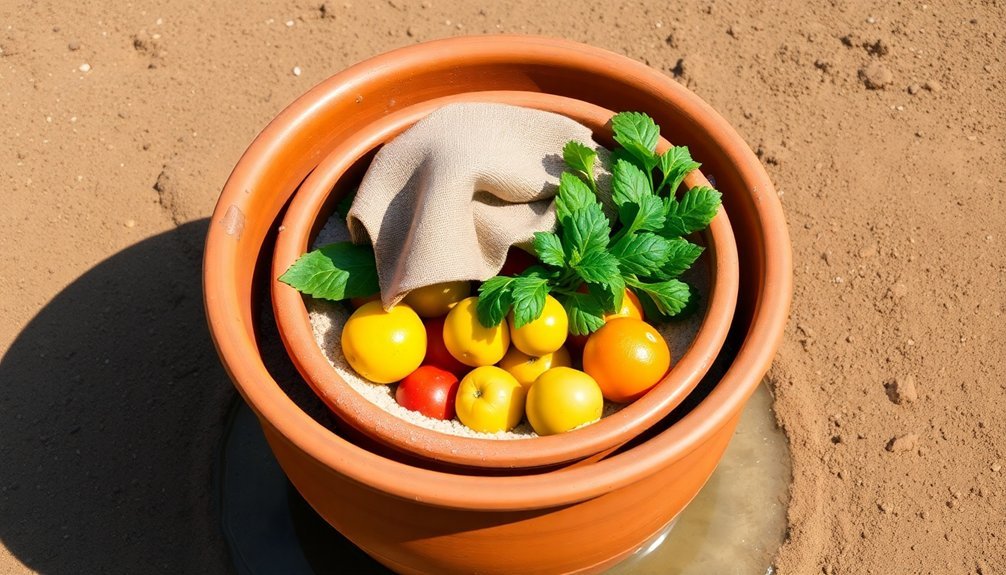
Three key factors make clay pot coolers remarkably effective at preserving food: evaporative cooling, constant air circulation, and maintained humidity levels. As water evaporates from the sand between the two clay pots, it converts sensible heat to latent heat, creating a cooling effect that can lower temperatures inside the inner pot to as low as 4.4°C in ideal conditions.
You'll find this preservation method particularly effective in arid regions with strong breezes, though it still works in humid areas with reduced efficiency. The continuous evaporation process maintains cool temperatures throughout the day, while fresh air circulation enhances the cooling effect.
You can expect significant improvements in food shelf life when using clay pot coolers. They'll extend the storage duration of vegetables by 50% to 600% compared to ambient storage, with 97% of users reporting better preservation results.
Common items like eggplants, tomatoes, hot peppers, cucumbers, and cabbage stay fresh longer. Beyond preservation, you'll benefit from reduced food waste, improved food quality, and lower risk of storage-related diseases.
This affordable method proves especially valuable in areas with limited electricity access.
Maintenance and Care
To maintain the impressive preservation benefits of your clay pot cooler, proper care and regular maintenance are necessary. Keep your cooler in a shady, well-ventilated area away from direct sunlight and guarantee good air circulation for maximum performance.
You'll need to monitor the moisture levels daily. Add water to keep the sand between the pots wet, and maintain a damp cloth or burlap covering over the cooler. Don't let the sand or covering dry out, as this will compromise the cooling effect.
When cleaning your clay pot cooler, don't use any dishwashing liquids or detergents, as they can seep into the porous clay. Instead, use a dry scouring pad or coconut fiber scrub to clean the pots, followed by a thorough rinse with tap water.
Regularly sponge off the inside of the cooler to maintain hygiene. Check frequently for cracks or leaks in the pots and replace them if damaged. If you notice mineral build-up, clean it with hot water and a sponge or use lemon juice.
Remember to keep the decorative rocks moist to protect the sand, and don't store meat, dairy, or medicines in your clay pot cooler.
Common Design Variations
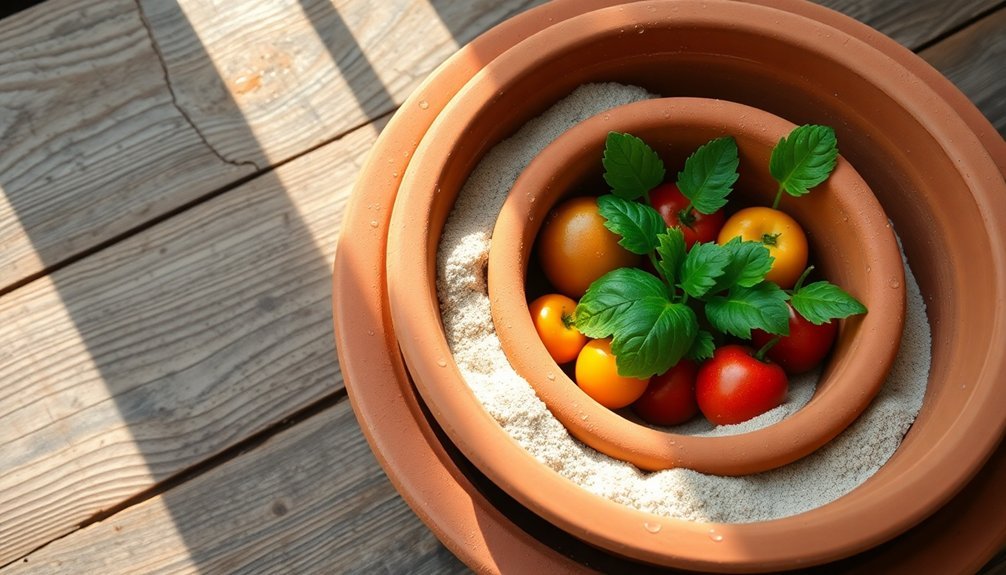
You'll find several practical variations of the ancient clay pot cooling method, with the basic two-pot design being the most common setup using nested clay containers separated by wet sand.
The sand-filled basin method offers a simpler alternative where you place a single clay pot in a larger plastic or metal basin filled with sand.
For a more streamlined approach, you can try the single-pot modified system, which incorporates built-in water chambers or specialized glazing instead of using two separate containers.
Basic Two-Pot Design
The basic two-pot design leverages evaporative cooling through a simple yet effective arrangement. You'll need two clay pots, with one small enough to nest inside the other, creating a gap between them. The inner pot can be glazed to prevent liquid seepage, while the outer pot should remain porous.
You'll fill the space between them with wet sand, which acts as your cooling medium. To complete the setup, you'll cover the top with a wet cloth or sack, enhancing the evaporation process. This system can effectively lower the interior temperature by up to 10°C below the surrounding air temperature, making it ideal for preserving fresh produce.
- You're preserving food using the same ingenious method that's sustained communities for generations.
- You're reducing waste and saving money without relying on electricity.
- You're making a positive environmental impact while keeping your food fresh longer.
The design works best in areas with low humidity, where evaporation occurs readily. You can even use non-potable water, like seawater, in the sand layer if your inner pot is properly sealed.
This affordable solution, costing between $5-$40, makes food preservation accessible to communities worldwide.
Sand-Filled Basin Method
Popular among modern DIY enthusiasts, sand-filled basin variations offer greater flexibility than the basic two-pot design.
You'll find this version particularly effective as it maximizes the cooling surface area by creating a wider gap between the containers. Using wet sand as both a thermal mass and a moisture-wicking medium, you'll need to position the inner pot about an inch above the outer container's surface.
You can enhance the cooling effect by placing decorative rocks or spacers to adjust the inner pot's height, ensuring ideal evaporation. The sand-filled method requires you to maintain consistent moisture levels, typically by adding water three times daily.
When properly maintained, you'll see temperature drops of up to 10°C below the ambient air.
For best results, you'll want to place your sand-filled cooler in a shady, well-ventilated area. It's crucial to cover the setup with a damp cloth to maintain humidity levels.
While this method won't match refrigerator temperatures, it'll effectively preserve various foods, from leafy greens to root vegetables. You can expect to spend between $5 and $40 on materials, making it an affordable solution for areas without reliable electricity.
Single-Pot Modified System
A simpler alternative to traditional zwei-pot designs, single-pot modified systems offer practical benefits while maintaining effective cooling capabilities.
You'll find these systems use a single clay vessel that's been specifically treated or modified to enhance evaporative cooling. Instead of relying on two separate pots and sand filling, these designs incorporate porous sections or specialized coatings directly into the container walls.
The cooling mechanism still relies on the same evaporative principles, requiring proper airflow and regular water application. You'll need to place your modified pot in a shaded, well-ventilated area to achieve peak cooling of up to 10°C below ambient temperature. While they're particularly effective in dry climates, you'll notice reduced efficiency in humid conditions.
- Save money with these budget-friendly units, typically costing 40-60% less than traditional zwei-pot systems
- Experience easier maintenance with simpler cleaning and reduced sand management requirements
- Enjoy greater portability thanks to the lighter, more compact design
For best results, you'll want to cover your pot with a damp cloth and guarantee regular water replenishment.
This system works exceptionally well for storing vegetables and fruits, helping you reduce food waste while preserving freshness.
Climate and Performance
Understanding how climate affects clay pot cooling systems reveals fascinating performance patterns.
You'll get the best results in arid or semi-arid environments where humidity levels are low. When ambient temperatures exceed 40°C, you can expect temperature reductions of 5-10°C, while brick ECCs can achieve even better cooling of 10-15°C above 35°C.
Location and environmental conditions play essential roles in your cooler's efficiency. You'll need to place it in a shaded area, as direct sunlight negates all cooling benefits. A well-ventilated space with a gentle breeze will enhance the cooling effect, while high humidity greatly reduces the system's performance.
To maintain ideal cooling, you'll need to keep up with regular maintenance. This includes consistent watering to keep the sand between pots wet and covering the cooler with a damp cloth.
You should clean the system regularly to prevent contamination, and you can remove mineral deposits using hot water and a sponge or lemon juice.
Cost and Material Requirements
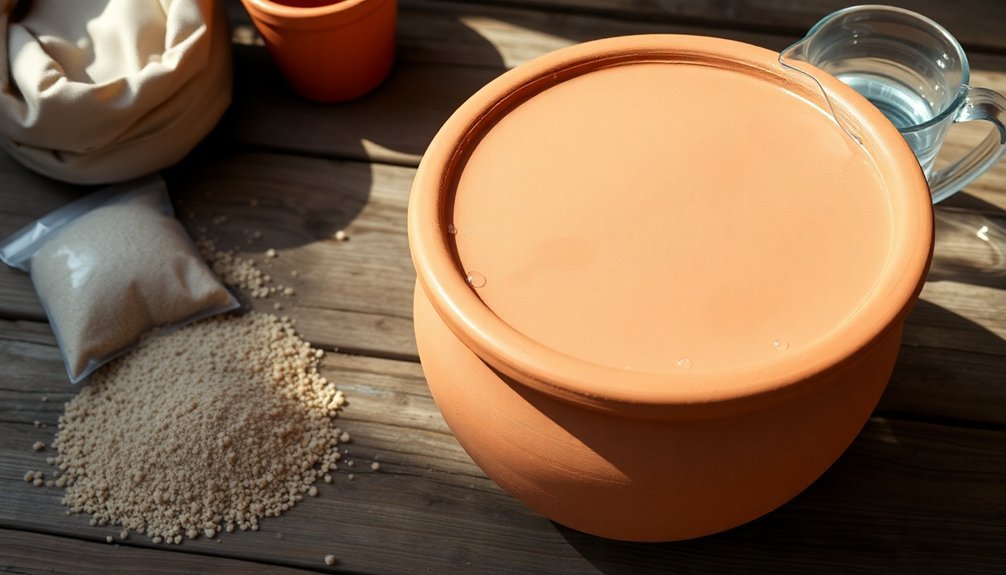
Building a clay pot cooling system won't break the bank, as most materials are readily available and affordable. You'll need two clay pots of different sizes, which typically cost between $7-$10 each, or you can opt for a plastic basin as the outer container to reduce costs.
The sand for filling the gap between pots is inexpensive and often locally available, while cloth or sacking for the covering will cost very little.
For a complete setup, you'll need:
- Traditional clay pots (matkas, ghara, or surahi) that connect you to ancient cooling methods used for generations
- Clean, coarse sand that will cradle your food storage vessel and maintain consistent cooling
- Simple cloth coverings that transform ordinary materials into an eco-friendly refrigeration system
If you choose to glaze the inner pot for better food safety, this might add to your initial investment but will extend the life of your cooler.
The total cost typically ranges from $5 to $40, depending on your choice of materials and size requirements. You'll need to budget for annual replacement of clay pots due to natural wear, but the ongoing maintenance costs remain minimal.
Local Market Availability
While the materials for clay pot coolers are budget-friendly, their availability varies considerably across different regions and markets. You'll find these coolers most readily available in local markets and roadside stalls throughout arid regions, particularly in Sub-Saharan Africa and the Indian subcontinent.
During hot summer months, you'll notice an increased presence of these cooling devices as seasonal demand rises.
You can purchase clay pot coolers through several channels. Local artisans and craftspeople often sell them directly in community markets, with prices ranging from $5 to $40 based on size and local material costs.
If you're looking to acquire one, you'll also find distribution networks established by NGOs, government initiatives, and local businesses that make these coolers more accessible.
In areas where traditional pottery practices are common, you'll discover that local craftsmen maintain regular stock of the necessary components.
Many organizations, including MIT D-Lab and the World Vegetable Center, have partnered with local vendors to guarantee consistent supply.
When shopping, you'll often find helpful guidebooks and instructional materials alongside the coolers, making it easier to assemble and maintain your purchase.
Long Term Storage Benefits
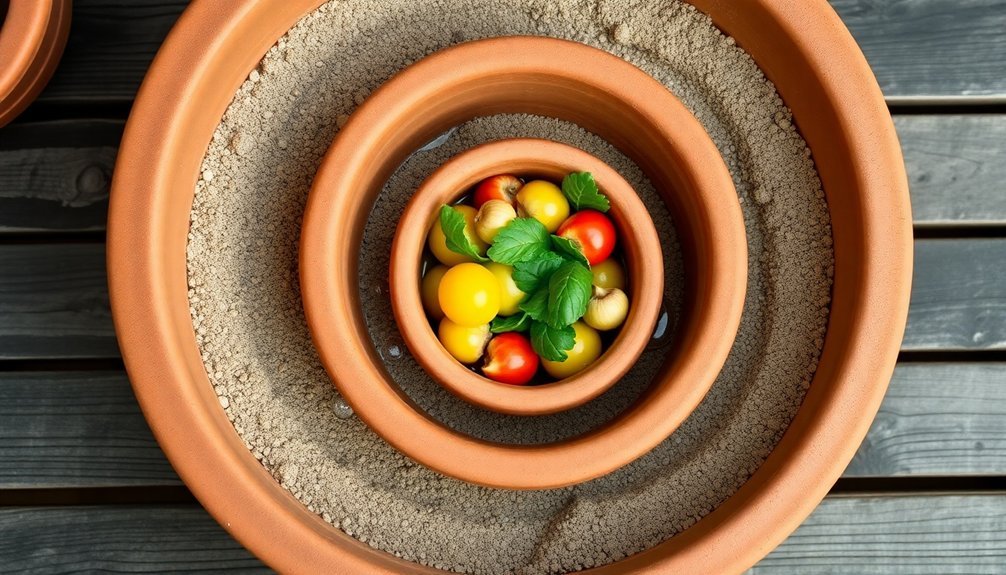
Clay pot coolers revolutionize food storage by dramatically extending the shelf life of fresh produce through simple yet effective evaporative cooling. When you store your fruits and vegetables in these traditional devices, you'll notice they stay fresh up to four times longer than conventional storage methods.
This remarkable preservation system can maintain temperatures up to 10°C below the surrounding environment, making it particularly effective in hot, arid climates.
You'll experience significant improvements in food longevity, especially with items like:
- Your leafy greens lasting four days instead of wilting after just one day
- Your tomatoes, eggplants, and okra maintaining freshness through natural humidity control
- Your market-bought produce staying crisp and nutritious for extended periods
The thermal mass of the sand and clay pots works continuously to maintain cool temperatures, even when you're accessing your food.
To maximize these benefits, you'll need to keep the cooler in a shaded, well-ventilated area and guarantee the sand stays consistently damp.
While you can't store meat in these coolers, they're remarkably effective for preserving most fruits and vegetables, helping you reduce food waste and maintain a steady supply of fresh produce.
Frequently Asked Questions
Can Clay Pot Coolers Be Used to Keep Drinks and Medicines Cold?
You shouldn't store medicines in clay pot coolers as they need precise temperature control. While you can cool drinks in them, they're not ideal – they work better for fruits and vegetables.
How Long Does the Wet Sand Between Pots Remain Effective?
You'll need to water the sand 1-3 times daily to maintain cooling effectiveness. In dry, ventilated areas, it'll stay effective for several days with regular watering, but effectiveness drops quickly if the sand dries out.
What Happens if the Inner Pot Accidentally Freezes in Cold Weather?
If your inner pot freezes, you'll risk cracking the clay due to water expansion. The frozen pot won't cool effectively, and your stored food could be damaged. You should protect it from freezing temperatures.
Are There Specific Types of Clay That Work Better Than Others?
You'll want to use highly porous clay like terracotta or earthenware. These natural clays work best because they're more permeable, allowing better water evaporation. Avoid dense clays like stoneware or porcelain.
Can Solar-Powered Fans Enhance the Cooling Effect of Clay Pot Coolers?
Yes, you'll get considerably better cooling with solar-powered fans, as they increase forced convection and evaporation rates. Your cooling efficiency can jump from around 7% to nearly 14% when you add a solar fan.
In Summary
You'll find clay pot cooling offers an eco-friendly, affordable way to preserve food without electricity. Whether you're living off-grid or seeking sustainable alternatives, this ancient method can keep your produce fresh for days. By following proper storage guidelines and choosing the right location, you'll extend your food's shelf life naturally. It's a practical solution that connects you to centuries of traditional cooling wisdom.

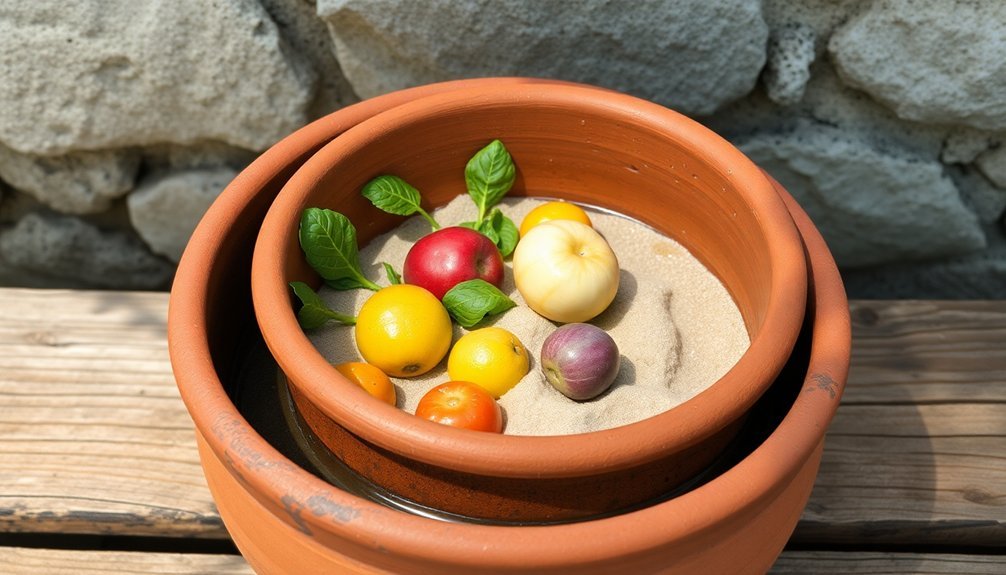



Leave a Reply